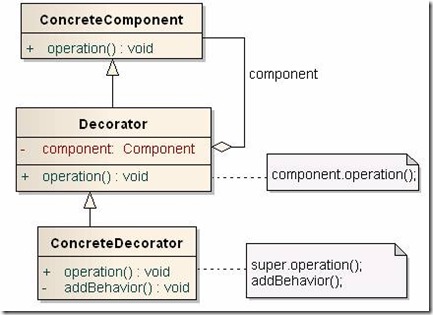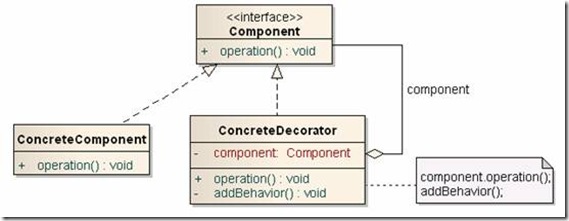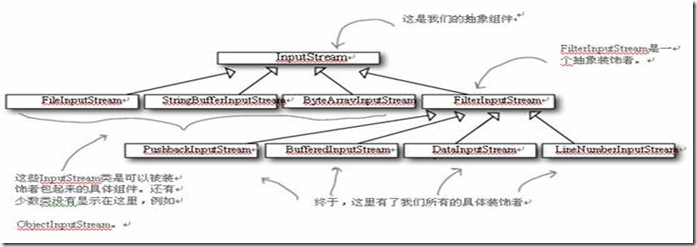1. 定义:装饰模式以透明的方式,动态地为一个对象(不是类)添加一些额外的功能(包含自身本身的功能)。又名包装模式(Wrapper);
2. 特性:提供了比用继承更灵活的替代方案。
3. 设计原则:
1). 多用组合,少用继承。
利用继承设计子类的行为,是在编译时静态决定的,而且所有的子类都会继承到相同的行为。然而,如果能够利用组合的做法扩展对象的行为,就可以在运行时动态地进行扩展。
2). 类应设计的对扩展开放,对修改关闭
4. 装饰模式与类继承的区别:
- 装饰模式是一种动态行为,对已经存在的类进行随意组合,而继承是一种静态行为,一个类定义成什么样的,该类的对象便具有什么样的功能,无法动态改变;
- 装饰模式扩展的是对象的功能,不需要增加类的数量,而类继承扩展的是类的功能,通过对覆写父类方法或添加新方法完成;
- 对于基类A,其已经有子类B,现在如果需要增加其它功能,则需要增加一个新的子类C,造成子类数量增多。装饰模式可以解决这一问题。
5. UML

装饰对象和被装饰对象有相同的接口。 这样客户端对象就可以和被装饰对象相同的方式和装饰对象交互。
装饰对象包含一个被装饰对象的引用;
6. 装饰模式的职责:
- 原始接口(Component):定义了一个接口方法;
- 默认目标实现类(ConcreteComponent):对原始接口的默认实现方式,被认为是有待扩展的类,其方法operation被认为是有待扩展的方法;
- 装饰类(Decorator):同样实现了原始接口,既可以是抽象类,也可以是具体实现类。其内部封装了一个原始接口的对象实例:targetComponent,这个实例往往被初始化成默认目标实现类实例。
- 具体装饰实现类:继承自装饰类Decorator,其中可以扩展默认目标实现类对象的功能
7. 实现代码
Component: 定义一个对象接口,可以给这些对象动态地添加职责。 public interface Component { void operation(); } Concrete Component: 定义一个对象,可以给这个对象添加一些职责。 public class ConcreteComponent implements Component { public void operation() { // Write your code here } } Decorator: 维持一个指向Component对象的引用,并定义一个与 Component接口一致的接口。 public class Decorator implements Component { public Decorator(Component component) { this.component = component; } public void operation() { component.operation(); } private Component component; } Concrete Decorator: 在Concrete Component的行为之前或之后,加上自己的行为,以“贴上”附加的职责。 public class ConcreteDecorator extends Decorator { public void operation() { //addBehavior也可以在前面 super.operation(); addBehavior(); } private void addBehavior() { //your code } }
8. 扩展
1. 如果只有一个Concrete Component类而没有抽象的Component接口时,可以让Decorator继承Concrete Component。
2. 如果只有一个Concrete Decorator类时,可以将Decorator和Concrete Decorator合并。
适用性:
以下情况使用Decorator模式
1. 需要扩展一个类的功能,或给一个类添加附加职责。
2. 需要动态的给一个对象添加功能,这些功能可以再动态的撤销。
3. 需要增加由一些基本功能的排列组合而产生的非常大量的功能,从而使继承关系变的不现实。
4. 当不能采用生成子类的方法进行扩充时。一种情况是,可能有大量独立的扩展,为支持每一种组合将产生大量的子类,使得子类数目呈爆炸性增长。另一种情况可能是因为类定义被隐藏,或类定义不能用于生成子类。
优点:
1. Decorator模式与继承关系的目的都是要扩展对象的功能,但是Decorator可以提供比继承更多的灵活性。
2. 通过使用不同的具体装饰类以及这些装饰类的排列组合,设计师可以创造出很多不同行为的组合。
缺点:
1. 这种比继承更加灵活机动的特性,也同时意味着更加多的复杂性。
2. 装饰模式会导致设计中出现许多小类,如果过度使用,会使程序变得很复杂。
3. 装饰模式是针对抽象组件(Component)类型编程。但是,如果你要针对具体组件编程时,就应该重新思考你的应用架构,以及装饰者是否合适。当然也可以改变Component接口,增加新的公开的行为,实现“半透明”的装饰者模式。在实际项目中要做出最佳选择。
9.扩展+
装饰模式在Java I/O库中的应用:
编写一个装饰者把所有的输入流内的大写字符转化成小写字符:
import java.io.FilterInputStream; import java.io.IOException; import java.io.InputStream; public class LowerCaseInputStream extends FilterInputStream { protected LowerCaseInputStream(InputStream in) { super(in); } @Override public int read() throws IOException { int c = super.read(); return (c == -1 ? c : Character.toLowerCase((char) c)); } @Override public int read(byte[] b, int offset, int len) throws IOException { int result = super.read(b, offset, len); for (int i = offset; i < offset + result; i++) { b[i] = (byte) Character.toLowerCase((char) b[i]); } return result; } } 测试我们的装饰者类: import java.io.*; public class InputTest { public static void main(String[] args) throws IOException { int c; try { InputStream in = new LowerCaseInputStream(new BufferedInputStream( new FileInputStream("D:\test.txt"))); while ((c = in.read()) >= 0) { System.out.print((char) c); } in.close(); } catch (IOException e) { e.printStackTrace(); } } }


